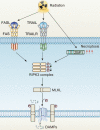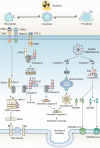In situ vaccination caused by diverse irradiation-driven cell death programs
- PMID: 38323315
- PMCID: PMC10845208
- DOI: 10.7150/thno.86004
In situ vaccination caused by diverse irradiation-driven cell death programs
Abstract
Interest surrounding the effect of irradiation on immune activation has exponentially grown within the last decade. This includes work regarding mechanisms of the abscopal effect and the success achieved by combination of radiotherapy and immunotherapy. It is hypothesized that irradiation triggers the immune system to eliminate tumors by inducing tumor cells immunogenic cell death (ICD) in tumor cells. Activation of the ICD pathways can be exploited as an in situ vaccine. In this review, we provide fundamental knowledge of various forms of ICD caused by irradiation, describe the relationship between various cell death pathways and the immune activation effect driven by irradiation, and focus on the therapeutic value of exploiting these cell death programs in the context of irradiation. Furthermore, we summarize the immunomodulatory effect of different cell death programs on combinative radiotherapy and immunotherapy. In brief, differences in cell death programs significantly impact the irradiation-induced immune activation effect. Evaluating the transition between them will provide clues to develop new strategies for radiotherapy and its combination with immunotherapy.
Keywords: Cell death programs; immunotherapy; in situ vaccine; irradiation.
© The author(s).
Conflict of interest statement
Competing Interests: The authors have declared that no competing interest exists.
Figures






References
-
- Upton AC. THE NUCLEUS OF THE CANCER CELL: EFFECTS OF IONIZING RADIATION. Exp Cell Res. 1963;24:Suppl9. 538-58. - PubMed
-
- Suit HD. Modification of radiation response. Int J Radiat Oncol Biol Phys. 1984;10:101–8. - PubMed
-
- Koski GK, Czerniecki BJ. Combining innate immunity with radiation therapy for cancer treatment. Clin Cancer Res. 2005;11:7–11. - PubMed
-
- Portella L, Scala S. Ionizing radiation effects on the tumor microenvironment. Semin Oncol. 2019;46:254–260. - PubMed
Publication types
MeSH terms
LinkOut - more resources
Full Text Sources
Medical

